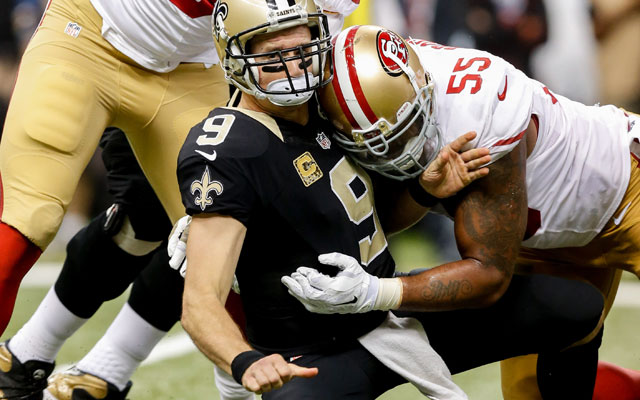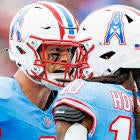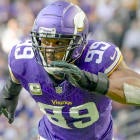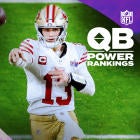
The New Orleans Saints, with aggressive, innovative coach Sean Payton leading the offense and star passer Drew Brees making pinpoint throws and quick decisions, have been one of the best big-play offenses in the NFL since they arrived together in 2006.
We've come to expect fast scores, high-scoring games and defenses that always seem to be on their heels.
In November, it has been more of an offense that doesn't have an identity, with a popgun passing attack and a quarterback who is missing throws he normally makes.
Consider this: In two November games, both at home where the Saints are usually prolific on offense, Brees is averaging 6.2 yards per attempt. That's his lowest number in a month since September 2007 and a big reason why New Orleans lost both games.
The Saints have three pass plays of 20 yards or more in the month, none last week in the loss to the Cincinnati Bengals. They had 17 in four games in October and nine in September, when the team got off to a slow start. Brees has averaged over four 20-plus completions per game the past three seasons. This season, it's 2.9 a game.
The Saints also have just six pass plays this season of 40 yards or more. The longest touchdown pass is 50 yards. The longest pass play is 57 yards.
It's not like the offense is a disaster or anything. The Saints are ranked second in total offense and tied for seventh in points per game. They are also third in passing yards and ninth in passing yards per attempt.
But the past two weeks should be cause for concern. That's why I went into a deep film dive to see what is wrong with this offense. Why is a team that has been so explosive at home in the Superdome suddenly so ordinary on the same turf?
Some of the things I found, and things I will highlight here:
- The interior of the offensive line, long a strength of this team and a necessary one with Brees being 6-feet tall, isn't close to what it has been in the past. The three inside players, center Jonathan Goodwin, left guard Ben Grubbs and right guard Jahri Evans, have all struggled at times the past two weeks -- especially in pass protection.
- The tight ends are not good blockers on the edge. For a team that wants to run it more -- another iffy decision -- that's a problem.
- They don't scare down the field. The lower passing-game stats show just that. The tape shows it even more.
- Brees is struggling some with accuracy down the field and he also seems to be taking the check-down throw more than usual. I know he has been really good at making decisions to check it down in his career, often leading to big plays for backs or receivers escaping coverage, but the past two weeks it seemed he passed on some shots to make the easier throws. To me, it looks like a case where he has less and less confidence in the guys in front of him.
Interior line problems
Let's start here. When the Saints and Brees were really good on offense, they had the best pair of guards in the NFL. They had Evans in his prime and Carl Nicks before he signed as a free agent with Tampa. Goodwin was the center, but that was before he left to go to San Francisco as a free agent, only to return this year.
Evans and Goodwin aren't close to the players they were four years ago. That shows up when Brees drops to pass. There is a lot of push inside.
As one defensive coordinator told me this year, "If you tell your guys to push up the field inside against him and get hands up, it creates a bunch of problems for him. He can't see. That's why he's always looking up."
That's what happened in both of the past two games. Both the 49ers and the Bengals played a lot of zone coverage, three-deep, two-deep and quarters, while mixing in some man concepts. It wasn't complicated and it appeared that the decision was made to keep everything in front and then tackle. And it worked.
Part of the reason it worked was the push inside. It didn't help that right tackle Zach Strief went out against the Bengals, which led to Carlos Dunlap owning his replacement, Bryce Harris, but it's the three inside that have always been more vital to Brees and his ability to see the field.
Those three also struggled at times in the run game, especially Goodwin and Grubbs. One of the keys to the Bengals' victory was stopping the Saints in the second quarter after they had a first-and-goal at the 4. They ended up with no points.
Even after a personal-foul penalty gave them first-and-goal at the 3, they couldn't get in. One of the plays I wanted to mention here came on that penalty. Defensive tackle Domata Peko tackled Mark Ingram for a 2-yard loss but got called for the personal foul. Even after that gave the Saints a first down, the Bengals still stopped them on downs.
On the personal-foul play, the Saints tried to fool the Bengals with reverse action to the left side of the offensive formation, bringing receiver Brandin Cooks around from the right to the left. But the Bengals' defensive linemen were slanting to the other side, to the run side. At the snap, Geno Atkins got inside of Grubbs and Peko got the best of Goodwin, getting great penetration. Ingram tried to bounce, but Dunlap was getting the best of Harris. Peko was able to grab him and throw him for a loss, although the way he did earned him a personal foul penalty.
Here's another look at a play where Peko handled the center inside and stopped a run play:
- Play: First-and-10 at the Bengals 43 with 14:47 left in the second quarter
- Offense: Posse (3WR, 1RB, 1TE) -- Shotgun, trips to right, spread
- Defense: Four-man front, nickel, quarters coverage look
On this play, the Saints tried to pull Grubbs around to lead Ingram into the hole on the right side. But Atkins blew up Grubbs' attempted trap, and that forced Ingram to try and bounce to the left. But Robert Geathers beat Terron Armstead inside and Peko was able to shed Goodwin and make the tackle for a 1-yard gain.
This poor play inside has been a problem in recent weeks, and has to improve or the Saints will continue to have problems scoring consistently.
Deep Passing Game Issues
There were plenty of plays the past two games that I can use to illustrate the issues the Saints are having winning down the field.
It's tough to get deep against deep zones, but I also think there is an issue with the Saints' big-play speed receivers. Kenny Stills can run but he has been inconsistent. Rookie Brandin Cooks can fly but he has been more of an intermediate threat, although he did have a 31-yard touchdown pass against the 49ers. He's now out for the season with a thumb injury. Marques Colston is still a solid veteran receiver, but he is really slowing down. That much you can see on tape.
This lack of productivity by the receivers has led to too many plays with Brees checking it down.
Here's a look one of those against the Bengals:
- Play: First-and-10 at the Cincinnati 19 with 10:48 left in the first quarter.
- Offense: 2WR, 2 TE, 1 RB
- Defense: Base 4-3, man-free
On this play, the Saints had both tight ends lined up as wings. The idea was to try and get the two receivers outside to win their out-and-up routes. Brees wanted to go to Stills on the offensive left side. He ran an out-and-up, but Adam Jones did a nice job in coverage. That forced Brees to reload. As he did, Colston was beating Dre' Kirkpatrick, who actually fell down, on his out-and-up. But with Atkins getting inside pressure against Grubbs, Brees just took the easy check-down throw to Ingram for a 4-yard gain.
Brees might have had a shot at tight end Josh Hill in man coverage against safety Reggie Nelson, but he opted for Ingram instead.
One of the things I noticed about Brees was that he missed several easy throws against the Bengals and forced some against the 49ers. That's unlike him. He is usually one of the most accurate passers in the league.
His completion percentage is still an impressive 69.5 percent, which would be the best he has had since 2011. But checking it down can help that number go up. His missed throws last week have to be concerning.
Early in the game, he missed Cooks on a wide-open crossing route that could have been a huge play. When I first watched the play, I thought it was a terrible throw. But after watching the tape, it was clearly on Cooks, who seemed to slow his route. Those are the little things this offense is missing.
Later in the game, Brees missed consecutive passes to Colston, with one being high and the other being behind. Here's a look at those two plays from the end-zone shot.
And later on, the pass thrown behind Colston:
It would be too easy to just put this all on Brees, as you can see from this analysis. Some will say he doesn't have the same zip on the football on his deep passes, and it might be off some, but that's not the issue from the past two weeks.
I also think this decision to be more run-heavy has impacted the pace of the offense. The Saints ran the football on four of their first five plays last week. They got 12 yards on those plays. When they went to their jumbo formations, with three tight ends, they still didn't get a lot of push in the run game.
Ingram has done a nice job running the ball this season, but ask yourself this: Would you rather take your chances with their running game or with Brees throwing it around 35-40 times a game, including on early downs?
Payton was always one of my favorite play-callers, arrogant to the point where he wasn't afraid to let it loose. He needs to get back to that. The Saints have been really good in the past at using formations to create matchup problems and free up receivers. That didn't happen the past two weeks.
The zone defenses just dropped, covered, tackled and moved to the next down. Brees seemed frustrated with the lack of the big play.
So expect the Ravens to do much of the same this week when they meet Monday night in New Orleans. Baltimore has a better pass rush than both Cincinnati and San Francisco, which might make it even tougher on the Saints' passing game.
More observations from watching the tapes this week
J.J. Watt Play of the Week: In my weekly look at a play involving Houston Texans defensive end J.J. Watt, I wanted to highlight something the Browns did to him that I think teams should use more frequently.
Watt is by far the best defensive player in the NFL, but if there's one thing that I think teams should use against him more, it's his aggressive style. He is so fast off the ball, and he sometimes gambles with his gap integrity, that I would trap him more. Let him come up the field, and then either trap him with a guard or "wham block" him with a tight end. The Browns got a big play doing just that last week.
Here's a look at that play:
Watt was lined up on the outside shoulder of the right tackle Mitchell Schwartz. At the snap, Schwartz blocked down to the inside and Watt came charging up the field. What he didn't expect was tight end Gary Barnidge to come back across the formation to wham block him. As Watt readied to make the play on running back Isaiah Crowell, Barnidge went low and cut Watt, who flew into the air as Crowell ran through a huge hole for a 35-yard run.
Later in the game, the Browns tried to do the same thing, only with fullback Ray Agnew, but Watt was able to avoid getting chopped down and helped to keep the play to a short gain. Watt spent most of his time lined up against Schwartz in this game, but on one of the few plays where he was matched up against Pro Bowl left tackle Joe Thomas he was able to get pressure on Brian Hoyer, actually getting a hand on him before Hoyer spun out of a potential sack on one play.
Watt also had a fumble recovery and a sack, just another day of putting up impressive defensive numbers. Oh, he also caught that touchdown pass on offense.
A closer look at Jadeveon Clowney: While watching Watt, I also took a look at rookie outside linebacker Jadeveon Clowney, who was playing in his second game since returning from a knee injury suffered in Week 1.
Clowney played a little more than half the snaps and had two tackles. He didn't get a sack, but had a couple of pressures. He was lined up most of the time opposite Thomas, who did a nice job in one-on-one situations against Clowney. There were times where Clowney looped inside to get pressure.
In the run game, Clowney made a really nice play by knifing inside of Barnidge to drop Crowell for a 1-yard loss. Clowney has to do a better job when rushing the passer of using his hands to get free of the tackle. Several times, Thomas just rode him up the field as Clowney's momentum took him there. Watt has great hands, so Clowney should lean on him for advice on how to use his better.
Key contributors on Cardinals defense: The Arizona Cardinals are third in run defense and fifth in yards per rush against. Calais Campbell, a player I highlighted here last week, is a big reason why. But two other players are also impacting that stat in a big way. They are nose tackle Dan Williams and defensive end Tommy Kelly.
Williams is having his best season, and as a pending free agent the timing is right. Kelly signed a one-year deal with the Cardinals after getting cut by the Patriots this summer. He has been a pleasant surprise, playing at a high level and making an impact with his pass rush as well. He doesn't have any sacks, but he got three pressures last week against the Lions. The Cardinals have some decisions to make on those two after the season, but I imagine they would want both of them back.
Patriots' Stork deserves some credit: New England running back Jonas Gray was a heck of a story last week, rushing for 201 yards and scoring four touchdowns against the Colts. He deserved the praise he has received all week.
But a guy who deserves some of that praise along with him is rookie center Bryan Stork, a fourth-round pick last May. He had his best game as a run blocker since taking over as the starter in the fourth week.
Stork isn't an overpowering center, but he is smart and knows how to use his angles and his body to get under the player in front of him. On Gray's first three touchdowns he made key blocks inside on all of them. On the fourth one, which was wider to the left, he did a nice job reaching to cut off the penetration by the defensive tackle. You can tell he is smart, and he knows how to use his hands.
Stork has some issues with power in pass protection at times, but he has the look of potentially being a quality center for a long time. His growth there has allowed the Patriots to play Ryan Wendell and Dan Connolly, two former starting centers, at guard. That trio works well together. They aren't big, but they are tough and smart.





















